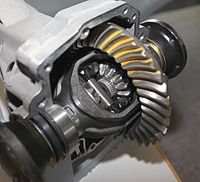Differential mechanism
A differential is the mechanical element that allows the right and left wheels of a vehicle to turn at different speeds, depending on whether it is taking a curve to one side or the other.
When a vehicle takes a curve, say to the right, the right wheel travels a shorter path than the left wheel. To understand it, we must remember that on an athletics track, the runner who takes the open turn covers more distance than the opponent who takes the closed turn.
In the past, the wheels of vehicles were fixedly mounted on the axle. This fact meant that one of the two wheels was not turning properly, destabilizing the vehicle. Through the differential, each wheel can turn correctly in a curve, without losing the fixation of both on the axis, so that the traction of the engine acts with the same force on each of the two wheels.
Operation
The differential consists of gears arranged in a "U" on the axis. When both wheels travel the same path, because the vehicle is going in a straight line, the gear remains in a neutral position, however, in a curve the gears move slightly, thus compensating for the different speeds of rotation of the wheels.
The difference in twist also occurs between the two axes. The steering wheels describe a larger radius circumference than the non-steering ones, for this reason the differential is used.
A four-wheel drive vehicle can have up to three differentials: one on the front axle, one on the rear axle, and a center differential.
In the hypothetical case that both axes are guidelines, the one with the greater angle of rotation will describe a greater radius.
Since an ordinary differential spreads the torque equally between both wheels (split 50%-50%), the maximum traction capacity is always twice that of the wheel with less traction. In the event that this is zero on one of the wheels, the total traction capacity is logically zero. To solve this problem, self-locking or lockable differentials are used. The latter can force both wheels to spin at the same speed, eliminating the differential effect and sending up to 100% of the torque to one wheel.
Contenido relacionado
Parallel computing
Basalt
Mobius function




